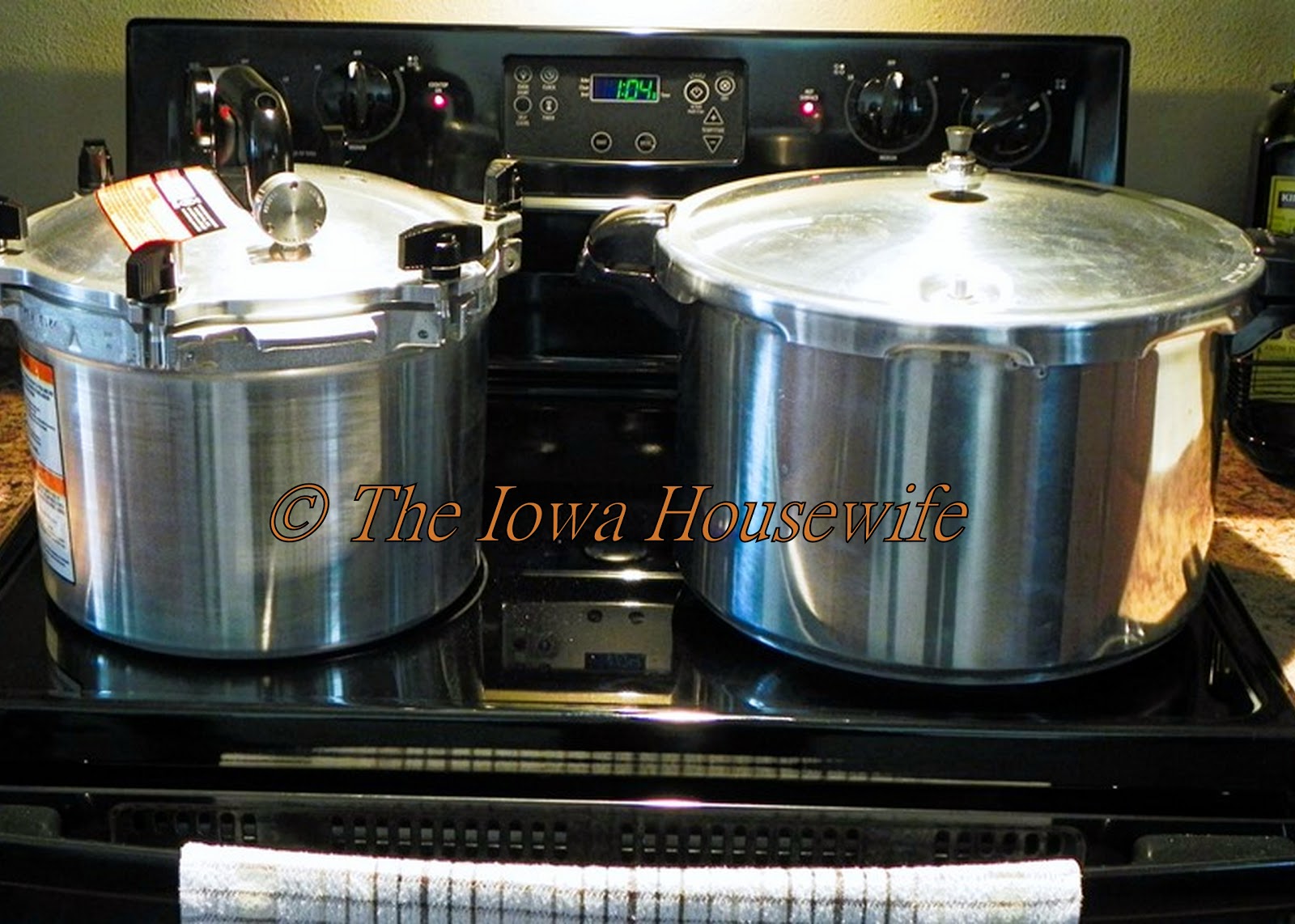 |
| Left: All American 10 quart Canner, Right: Presto 16 quart Canner |
Pressure canners are a must if you can meat, fish, poultry, dry beans and vegetables or other low-acid foods; and these products are the ones I can the most. I like having jars of good food ready to use without thawing and it takes a load off my small freezer.
Don’t substitute a “pressure cooker” for a canner, it heats up too quickly and cools down too fast to meet the processing requirements for your recipe. You can tell if it’s a pressure cooker; it is 8 quart or less capacity, and doesn’t have variable 5-10-15 pound weights. The smallest CANNER available now is an All American 10 quart, which I have and like, it has both a dial and variable weight. I use it to can smaller amounts, and as a second canner when I have more than my Presto will hold. Some large canners don't have variable weights either, but have a pressure dial.
I used to have a Presto 23 quart…it got too heavy for me to handle, and I no longer double-stack jars as I did when I canned larger quantities and had help. I never have felt that having the bottom jars already cooking while I filled the top row was a good idea. Because of that, I use single-stack canners. If you can a lot and have help, the canners large enough to double-stack may be just the ticket.
I used to have a Presto 23 quart…it got too heavy for me to handle, and I no longer double-stack jars as I did when I canned larger quantities and had help. I never have felt that having the bottom jars already cooking while I filled the top row was a good idea. Because of that, I use single-stack canners. If you can a lot and have help, the canners large enough to double-stack may be just the ticket.
 |
| Left: Stainless Steel Stockpot with rack for water bath canning; Right: Mirro 12 quart Pressure Canner |
All of them have "jiggler" weights, which I prefer, because I don't want to be tied to watching a dial when I can listen instead. The larger Prestos have dial gauges and the weight is not calibrated for 5-10-15 pounds, so you have to watch the dial, which I hate. At our Iowa altitude (under 1000' but close to it) the weighted gauges work very well and your product won't be over-processed. Many University extension service offices are no longer checking pressure canner gauges either. I also think that you have a tendency to do less “fiddling” trying to get the pressure right with a jiggler weight, and prevent some bad jar seals that way.
 |
| Presto 16 quart canner with single rack and book |
Check with manufacturers websites to see what their jar capacity is for different models, keep in mind that some jars are larger in circumference than others; my old Kerr jars are the smallest, Ball are in the middle and I usually have to put one less jar in when I use all Golden Harvest jars. The stated canner capacity is for filling it with liquid, not jars.
I think that of these, I would buy the Presto first...it is fairly lightweight, the price is right, it’s a good size, I can use it on my glass-top range as well as a regular range, and it does a good job. I've never replaced the gasket but they are available and not expensive at our local True Value Hardware. Our local Walmart was out when I wanted this canner and they shipped it to my door without shipping charges. I see that this year, it is about the same price as I paid several years ago.
The All-American is great...but it's expensive, heavy to lift, and more complicated to use, with the screw-down seals, etc. You have to oil the sealing surfaces to keep it from locking on...some folks have had trouble with that. It doesn't have heat-proof handles. That said, it will probably last forever, and it has both a weighted gauge and a dial, and doesn't have a gasket that needs to be replaced. I especially like the smallest size for smaller canning jobs.
 |
| All American handle and screw-down detail |
All of these newer pressure canners work on my glass-top stove as well as my previous types of stoves.
I had my first pressure canner for years until I passed it on thinking I was through canning...big mistake on my part! They last forever, and with a little care, they don’t cost much after the first investment.
I think you will enjoy pressure canning...it's a hobby that saves money if you garden or hunt or raise your own meat and poultry (or even buy larger amounts on sale) and it's satisfying to just open that jar of meat or soup or stew for dinner without thawing and to see all those full jars on your shelves.
I think you will enjoy pressure canning...it's a hobby that saves money if you garden or hunt or raise your own meat and poultry (or even buy larger amounts on sale) and it's satisfying to just open that jar of meat or soup or stew for dinner without thawing and to see all those full jars on your shelves.
















I have a big one from my mom, but I don't can meat. So, I just use my big pot to do my pickles in a water bath.
ReplyDeleteThat works too!
DeleteThank you for another educational article. I cook in my pressure canner, but want to learn to can.
ReplyDeleteThe 22-23 quart canners can be used for water bath canning in addition to pressure canning. I use mine for this as it takes less water and fits the electric coils of my stove better than a regular water bath canner.
ReplyDeleteAnd less room needed to store big canning eqipment too!
DeleteI meant to include in my previous comment that a Presto canner with a dial gauge can be converted to a "jiggler" type canner by substituting Presto's 3 piece regulator for the one piece regulator. When I first heard this was possible I contacted Presto and received confirmation that it can be done. Each piece equals 5 pounds of pressure. I, too, like the ability to "listen" to the canner while doing something else.
ReplyDeleteI had heard that could be done...good to know that Presto confirmed that! Thanks for sharing.
Delete